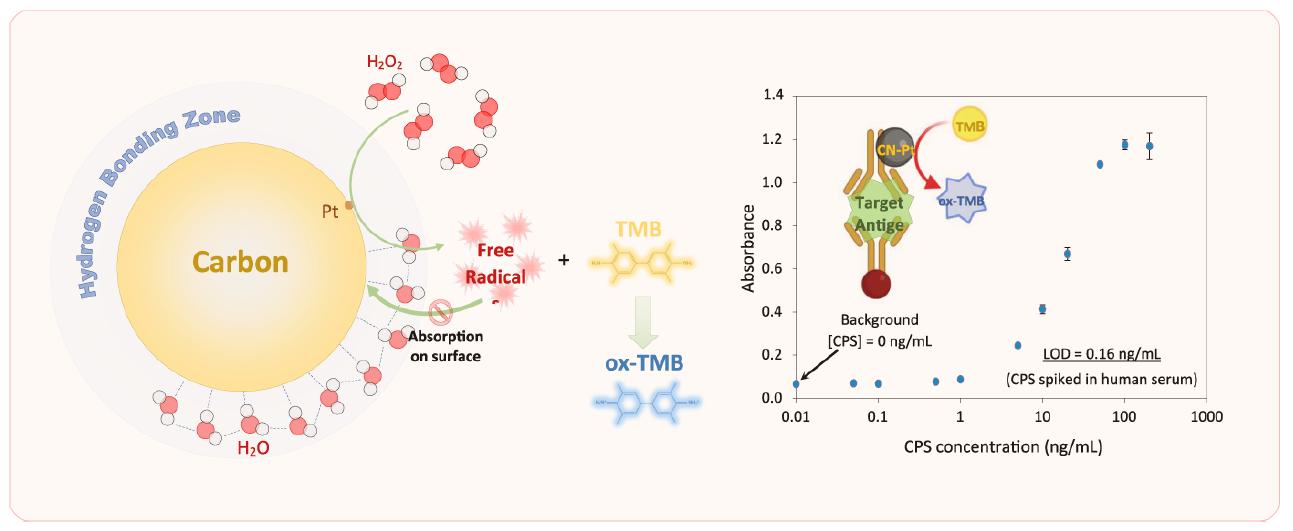University of Nevada, Reno's Carbon-Platinum Nanozyme Technology Licensed for Commercial Development
A novel carbon-platinum (CN-Pt) nanozyme, developed by researchers at the University of Nevada, Reno, has been licensed for commercial use. This innovation represents a significant advancement in the field of diagnostics and biosensing, addressing a key limitation of many existing nanozymes: low catalytic efficiency. Nanozymes are nanomaterials with intrinsic enzyme-like activity that have gained significant attention for their stability, low-cost production, and enzyme-mimicking properties. Among these, peroxidase-mimicking nanozymes are widely used in disease diagnosis and biosensing, catalyzing peroxide decomposition to generate a detectable signal. However, many existing nanozymes have suffered from low catalytic efficiency, which has significantly limited their sensitivity in bioassays. The newly developed CN-Pt nanozyme overcomes this challenge, offering a powerful tool for a wide range of applications in diagnostics and pathogen control.
The CN-Pt nanozyme is created by depositing tiny platinum nanoparticles (1–2 nm) onto nitrogen-doped carbon nanoparticles. This design significantly boosts its peroxidase-like activity, making it a superior alternative to traditional horseradish peroxidase (HRP)-based assays. The nanozyme has demonstrated record-high catalytic activity, achieving 1.97 M·mL/s·g for H₂O₂ and 1.27 M·mL/s·g for TMB, which is one to two orders of magnitude higher than many other carbon-noble metal nanozymes. This high efficiency allows for the ultrasensitive detection of pathogens like Burkholderia pseudomallei with detection limits as low as 0.11 ng/mL in buffer and 0.16 ng/mL in human serum.

The CN-Pt nanozyme also offers several practical advantages that set it apart from other nanozymes:
- Higher Catalytic Activity: The CN-Pt nanozyme demonstrates peroxidase-like activity with catalytic constants for H₂O₂ and TMB that are one to two orders of magnitude higher than many previously reported carbon-noble metal nanozymes. This record-high activity enables ultrasensitive pathogen diagnostics.
- Ultra-sensitive Detection: The technology enables sub-ng/mL detection, which is critical for highly sensitive pathogen diagnostics. This level of sensitivity was demonstrated with the detection of Burkholderia pseudomallei at limits as low as 0.11 ng/mL in buffer and 0.16 ng/mL in human serum.
- High Colloidal Stability: Unlike many conventional core-shell nanozymes, CN-Pt nanozymes naturally exhibit high colloidal stability for weeks without the need for surface modification.
- Simplified Bioconjugation: The nanozyme can be easily conjugated with antibodies (proteins) via electrostatic absorption, eliminating the need for complex bioconjugation procedures.
- Enhanced Thermal Stability: The CN-Pt nanozyme retains approximately 80% of its enzymatic activity at 45°C, making it suitable for a diverse range of operational environments.
- Lower Cost: The technology significantly lowers the consumption and use of noble metals in nanozyme synthesis when compared to other Pt-nanoparticle based nanozymes.
The potential applications of this CN-Pt nanozyme are extensive and diverse. In clinical and laboratory diagnostics, it can be used to enhance immunoassays for the detection of various biomarkers and pathogens, thereby improving the accuracy and speed of medical testing. Its superior performance and stability make it an ideal candidate for incorporation into colorimetric biosensors. Additionally, the technology can be leveraged for antibacterial and antiviral applications, as the nanozymes react with H₂O₂ to generate reactive oxygen species (e.g., O*) that effectively break down pathogens. This capability opens up opportunities for novel nanozyme-based pathogen control strategies and disinfection methods. The combination of high catalytic activity, ultra-sensitive detection capabilities, and stability makes this nanozyme particularly suitable for developing point-of-care rapid diagnostic tools. These tools could provide fast, accurate results in various settings, from hospitals to remote field operations, offering a significant advantage over current methods.
Contact us for detailed information.
Contact us or send an email at for project quotations and more detailed information.
Quick Links
-

Papers’ PMID to Obtain Coupon
Submit Now -

Refer Friends & New Lab Start-up Promotions

